If you’re a jazz guitarist, you’ve spent time working out chord shapes on the guitar but have hit a roadblock or two along the way. You’ve learned dozens of cool-sounding grips, but when it comes time to apply these shapes to a tune, things fall apart.
Learning how to play chords and how to comp over your favorite jazz standard requires different skills and a different approach to practicing.
To help you expand your playing from memorizing shapes to comping with confidence over jazz tunes, here are 5 essential jazz chord exercises for guitar. Each of these exercises will take your chord playing to the next level, expanding your confidence and chord vocabulary at the same time.
So, grab your guitar, turn on your amp, and get ready to push yourself to new levels of excitement and engagement in your jazz guitar comping phrases.
Chord Qualities in Position
The first jazz chord exercise in this lesson is one of the most fundamental and important chord exercises you can practice.
This exercise involves playing a maj7 chord on the guitar, then altering one note at a time to produce the next chord in the sequence. When doing so, you’ll be flattening one note to produce the next chord, such as flattening the 7th of a maj7 chord to produce a dominant 7 chord.
Here’s the order of chord qualities that occurs when you begin on maj7 and work your way down to dim7 chords on the fretboard.
- Maj7
- 7
- m7
- m7b5
- dim7
To help you visualize this movement, altering one note at a time to produce the next chord, here’s a handy chart.
| Cmaj7 | C | E | G | B |
|---|---|---|---|---|
| C7 | C | E | G | Bb |
| Cm7 | C | Eb | G | Bb |
| Cm7b5 | C | Eb | Gb | Bb |
| Cdim7 | C | Eb | Gb | A |
Now that you know how to change one note to produce the next chord in the sequence, you can apply this concept to the fretboard.
Beginning with drop 3 chords on the 6432 string set, here’s an example in the key of C that you can practice in your jazz chord studies.
The note in blue is the one that is moving between each chord shape.
Listen & Play Along
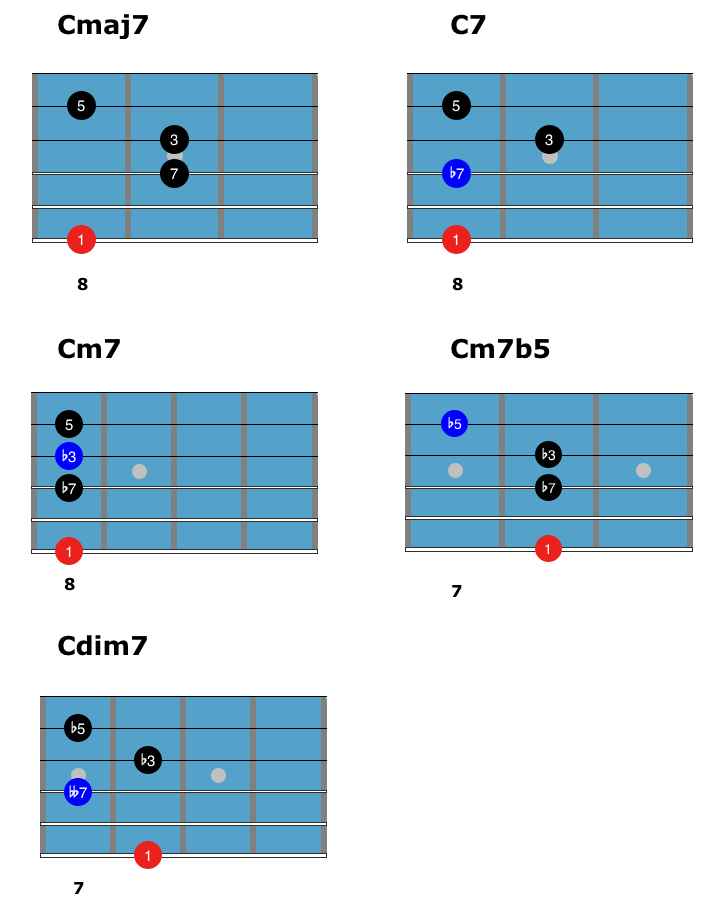
As well as work on chord qualities in root position, you can apply this jazz chord exercise to inversions as well.
Here’s an example of drop 2 chords in second inversion on the top 4 strings to explore in your jazz practice routine.
Listen & Play Along
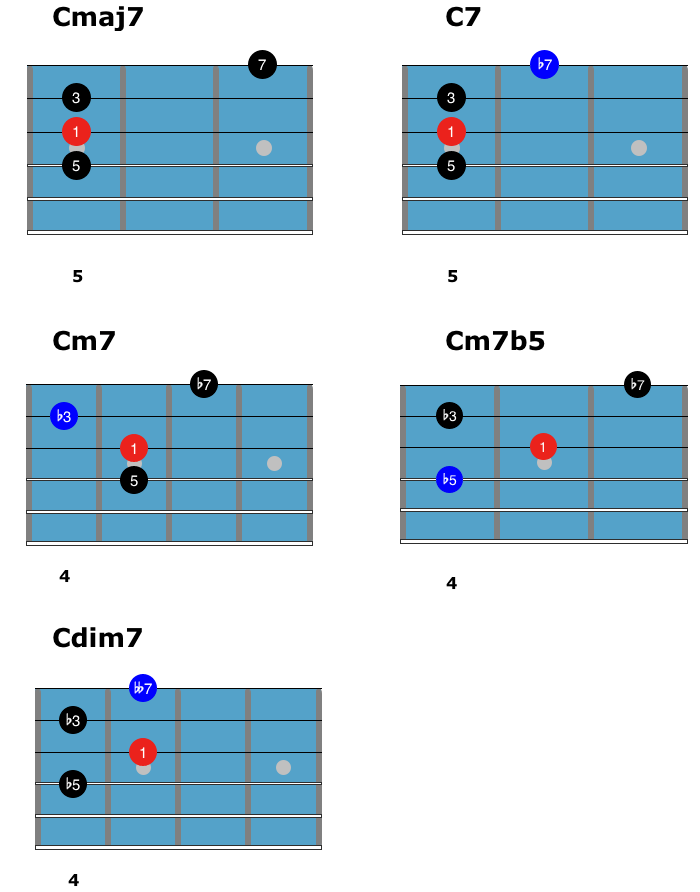
After you’ve worked out these examples, move them both to other keys, as well as apply this exercise to other inversions, chord types, and string sets in your studies.
Chord Inversions
Speaking of inversions, working chord inversions across the fretboard is an effective way to learn chord shapes in any area of the guitar.
As well, inversions feature different intervals on top of each chord shape, which will come in handy when working on chord melody arrangements on guitar.
This exercise is fairly simple on paper but can be difficult to visualize and execute on the fretboard.
Here are the steps for this jazz chord exercise that you can follow in your studies:
- Pick a chord type – such as drop 3
- Pick a chord quality – such as dominant 7
- Pick a string set – such as 6432
- Pick a key to work in – such as G
- Play the G7 drop 3 inversions on the 6432 strings from memory
- Repeat with other keys
From there you can apply this exercise to any key, chord type, chord quality, and string set.
Here’s an example of those same G7 drop 3 chords on the 6432 string set:
Listen & Play Along
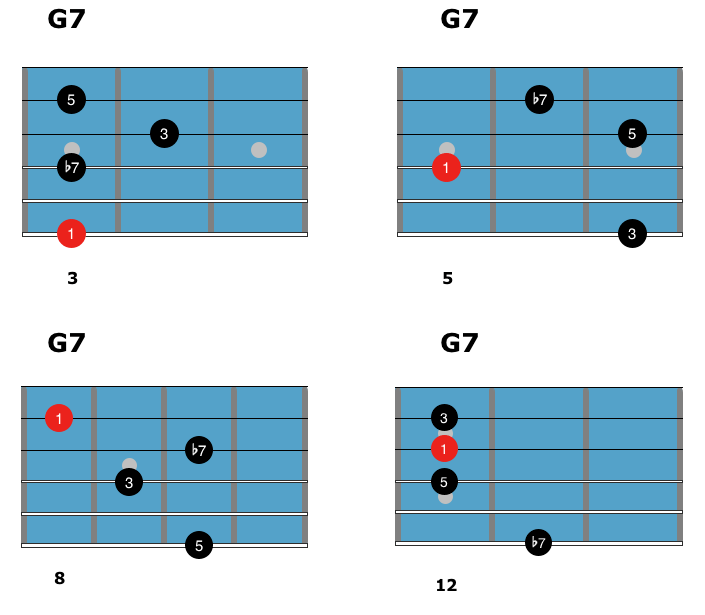
For a bit of variety, here’s a Cm7 drop 2 chord taken through its various inversions on the top-4 strings.
Notice that you begin higher up the fretboard with the Cm7 shapes, and then jump down once you get too high on the fretboard to continue with your inversions.
Listen & Play Along
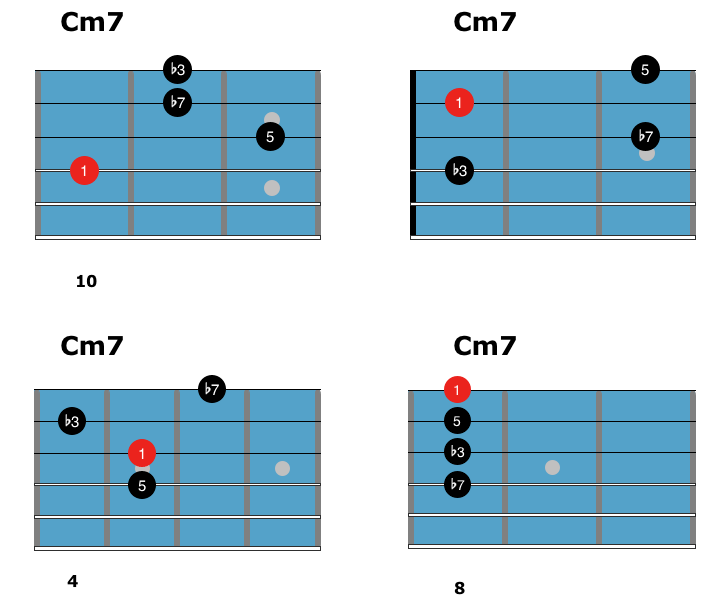
After you’ve explored these two examples, take them both to other keys on those string sets, before moving to other chord types, qualities, and string sets.
ii V I Inversions
Moving forward, you can now begin to work chord progressions in inversions, starting with the most popular jazz progression of all, the ii V I.
When working this exercise, you start with the ii chord, move to the closest inversion of the V chord, and then the closest I chord from there.
Here’s an example of this exercise using drop 2 chords in the key of F major.
Listen & Play Along

As well as working this exercise from a root-position ii chord, you can start on any inversion of the ii chord and move to the closest V and I shapes from there.
Here’s an example of that using drop 3 chords, with the iim7 chord being in first inversion and the rest moving to the closest shape from that point.
Listen & Play Along

Working on ii V I changes means working in major and minor keys, and so you can apply this jazz chord exercise to minor ii V I progressions in your studies as well as major.
Here’s an example of a ii V I in the key of A minor, with the closest inversions being used for each chord after the iim7b5 chord gets things moving.
Listen & Play Along

As was the case in the major progression, you can apply this concept to a iim7b5 inversion, moving to the closest inversion from that starting chord in your playing.
Here’s an example of that approach using drop 2 chords on the top-4 strings, with the iim7b5 being a 3rd inversion and moving to the closest shape from there.
Listen & Play Along

After you’ve worked out these examples, you can apply this exercise to other chord types, inversions, and string sets in your studies.
Chord Scales
Another effective jazz chord exercise is chord scales, where you play a series of shapes through a key on the fretboard.
Here are the steps for building this exercise in your studies.
- Pick a chord type – such as drop 3
- Pick a string set – such as 5321
- Pick a key – Bb major for example
- Start on the Imaj7 chord and play each chord in the key from there
Sounds pretty simple on paper, but it can be tricky to execute, especially if you’re just getting into finding chords in any given key.
Here’s that same example on the fretboard to help you visualize this exercise on the guitar.
Listen & Play Along

As well as working chord scales in root position, you can use any inversion you’re working on with this exercise in your studies.
Here’s an example of a chord scale built with drop 2 chords on the middle four strings in the key of E, using the 2nd inversion for each chord.
Listen & Play Along

As you can see, chord scales allow you to play around the entire fretboard, without simply running inversions of chords in your playing.
When you’ve got these two written examples under your fingers in the given key, take them to other keys before moving on to other shapes and string sets.
If you find it challenging to work chord scales on the spot in your playing, you can write out any chord scale your studying on paper.
Then, after you’ve worked it out, you can memorize that chord scale on the fretboard as you take the exercise further in your studies.
Tune Studies
The final jazz chord exercise involves taking inversions and various chord types to full jazz standards in your studies.
When doing so, you have two options:
- The first option is to write the chords out with a plain rhythm, whole and half notes for example. Then, you’d add in your own rhythms as you played through the study on the guitar.
- The second option, which you can see below, is to construct a full comping study over the tune. This means including chord shapes, inversions, passing chords, melodic phrases, etc. as you emulate a real-life comping situation as much as possible in the study.
To get you started with this second approach, the more complex of the two on paper, here’s a chord study over the tune Bluesette.
You can learn the study as written, then begin to alter the rhythms, picking-hand attacks, and the chords themselves as you begin to personalize the study.
Once you have it down and can bring your personality to the study, write out a jazz guitar chord study of your own.
You can use this tune as a vehicle for that study, or you can pick any jazz standard you’re working on and use that in your practice routine.
Backing Track
Listen & Play Along
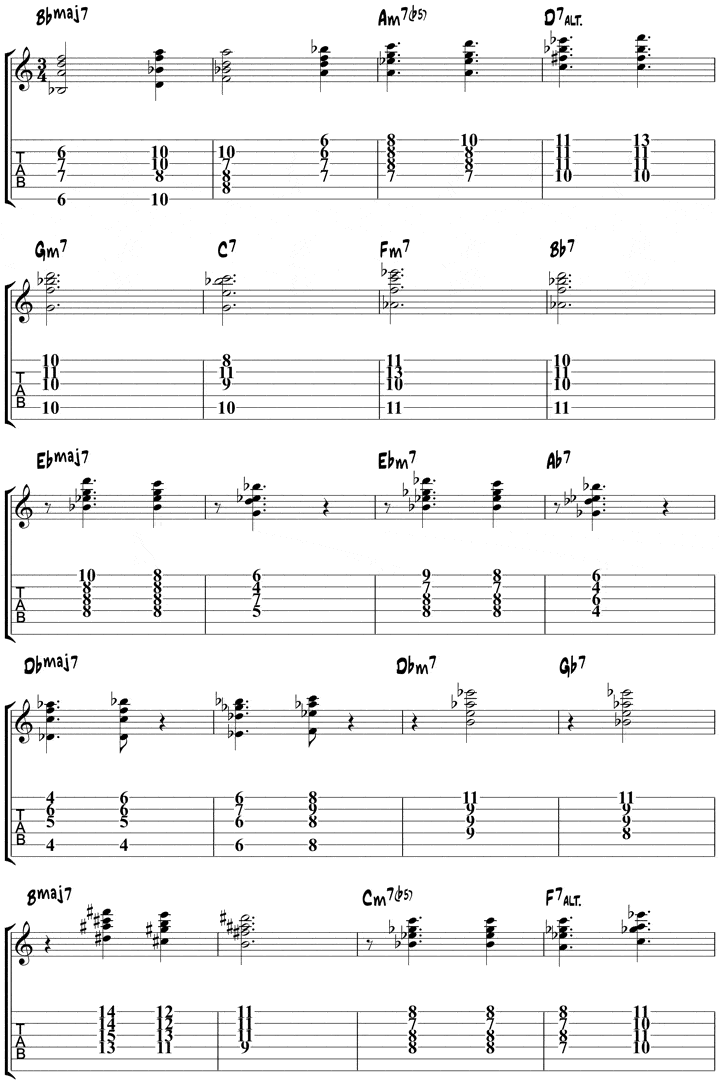




very good method I teach jazz guitar your method looks a bit like mine by searching a little I will always find a chord or a set of notes that interests me thank you for everything
best wishes
Amazing way of explaining, everything was clear and easily understandable 😊
Hello again Matt!!
Simply beautiful!! And a good opportunity to learn this Fm7 strange-shaped chord in Bar 7. Is this a Drop 3 voicing by the way?
How would you call this chord study over “Bluesette”? A chord melody or something?
THANKS
thanks, it’s a drop 3 inversion. I just call it a chord study. It’s not a chord melody as you’re comping the chords but not using the melody in the top notes. Cheers.
great
Thank you very much for providing all those great lessons. But just as a comment from a rock guitar player trying to get into Jazz.
I would really appreciate to also see appropriate fingerings for the chords. Some of them like the maj7 I would play as a barre, but then changing over to e.g. b7m5 does not work.
This was a great lesson, as always. Laurent, I agree with you. Oftentimes, the fingering is the challenge, perhaps less so for chords than melody, but still always a factor.
I don’t know how you do it but please don’t stop. My only problem is jumping from one lesson to the next. Trying to stick to the Better Guitar book which is so great.
thanks
Great exercise suggestion. I was struggling not with the chord theory, but with effective methods of practice. This will help me greatly.
Thank you
Great lesson! Thanks
What a nice compact explanation with accompanying exercises. A new practice exercise with which to drive my family crazy! Thanks for putting this together.
I know what I will be working on over Christmas. Thanks so much.
Of real practical value. An excellent set of exercises. Many thanks guys for putting this together
Thanks very much, I think that this is a really clear and important lesson, that highlights the importance of chord study and suggests a very effective way for gaining more control and freedom in jazz comping. Well done!
thanks. it’s simple and understandable
Excellent lesson guys. Thank you.
Real good job. Thank you. And don’t forget…the secret is…work.
absolutely great tuition, not to mention the high quality of presentation.. thanks so much for the inspiration guys..so much to work on.
Absolute fantastic lesson, thanks guys.,,,
excelent